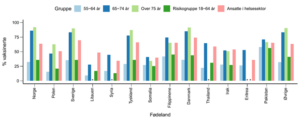Stan szczepienia różni się w zależności od kraju urodzenia
Stan szczepień różni się w zależności od kraju, w którym się urodziłeś. Świadczy o tym przeprowadzony przez Norweski Instytut Zdrowia Publicznego przegląd odsetka szczepionych w różnych grupach imigrantów. Nie wiadomo, co może być przyczyną tych różnic.
– Program szczepień w Norwegii jest dobry. Ale widzimy, że istnieją różnice w niektórych grupach imigrantów, mówi dyrektor kontroli zakażeń Geir Bukholm z National Institute of Public Health.
Epidemia Covid-19 w Norwegii szczególnie dotknęła w niektóre grupy imigrantów. Osoby urodzone za granicą były wśród zarażonych i hospitalizowanych przez cały okres epidemii.
W nowym przeglądzie szczepień w oparciu o kraj urodzenia Narodowy Instytut Zdrowia Publicznego (NIPH) przyjrzał się w szczególności trzem grupom. Odsetek zaszczepionych w najstarszych grupach wiekowych, odsetek zaszczepionych wśród osób w wieku 18-64 lat z ryzykiem poważnej choroby podstawowej oraz odsetek zaszczepionych wśród pracowników służby zdrowia.
Rysunek 1 Odsetek osób zaszczepionych co najmniej jedną dawką szczepionki wśród osób w różnych krajach urodzenia. Jest to pokazane w podziale na grupy wiekowe, grupy ryzyka medycznego ciężkiego przebiegu Covid-19 oraz pracowników służby zdrowia

Stan szczepienia w najstarszych grupach wiekowych
Norweski Instytut Zdrowia Publicznego obliczył odsetek osób zaszczepionych w różnych grupach, wykorzystując dane z rejestru szczepień oraz innych rejestrów połączonych w specjalny rejestr pandemiczny Beredt-C19 z dostępem m.in. do rejestru populacyjnego, rejestrów zawierających dane o medycznych czynnikach ryzyka oraz rejestrów osób zatrudnionych w różnych sektorach gospodarki. Obliczono odsetek zaszczepionych w trzech grupach: rezydentom w różnych grupach wieku pow. 55 r.ż., osobom w wieku 18-64 lat
Osoby z chorobami oraz zwiększonym ryzyku poważnego przebiegu
Osoby w wieku od 18 do 64 lat z chorobami podstawowymi lub stanami, które zwiększają ryzyko poważnego przebiegu zakażenia COVID-19, mają bardziej wyrównany odsetek zaszczepionych. Najwyższe wykonawstwo szczepień było wśród osób urodzonych w Pakistanie (56%) i na Filipinach (45%). Tak samo było w krajach skandynawskich. Jednocześnie najniższe wśród osób urodzonych w Iraku (27%), Somalii (25%), Polsce (21%), Erytrei ( 22 Litwa (17%) i Syria (13%).
Przeczytaj także: Uprawnienia rządu w czasie kryzysu
Stan szczepienia różni się w zależności od kraju urodzenia.Pracownicy służby zdrowia
Odsetek szczepień w służbie zdrowia jest najwyższy wśród osób urodzonych w Danii (74%) i Szwecji (70%), a najniższy wśród osób urodzonych w Somalii (39%), Erytrei (36%) i Syrii (34%).
Różnice w obszarach priorytetowych
NIPH przyjrzał się również różnicom w zasięgu szczepień między priorytetowymi i niepriorytetowymi obszarami geograficznymi.
– Zidentyfikowane różnice dotyczą przede wszystkim odsetka zaszczepionych w grupie wiekowej 55-64 lata. Obszary o priorytetach geograficznych mają wyższy odsetek zaszczepionych wśród wszystkich grup etnicznych w kraju. Osoby urodzone za granicą mają równie wysoki odsetek szczepień, jak osoby urodzone w Skandynawii, mówi Bukholm.
Kilka różnych powodów
Nie wiadomo dokładnie, jakie są różnice w liczbie zaszczepionych między różnymi krajami pochodzenia.
– Nie wiadomo, jaka jest przyczyna zróżnicowanej liczby szczepień. Bariera językowa lub inne praktyczne bariery, takie jak dostępność, mogą przyczynić się do tego, że niektórzy nie skorzystali z oferty. Informacje, które otrzymaliśmy, są cenne w dalszych pracach nad zapewnieniem wszystkim jednakowej oferty szczepień – podsumowuje Bukholm.





















